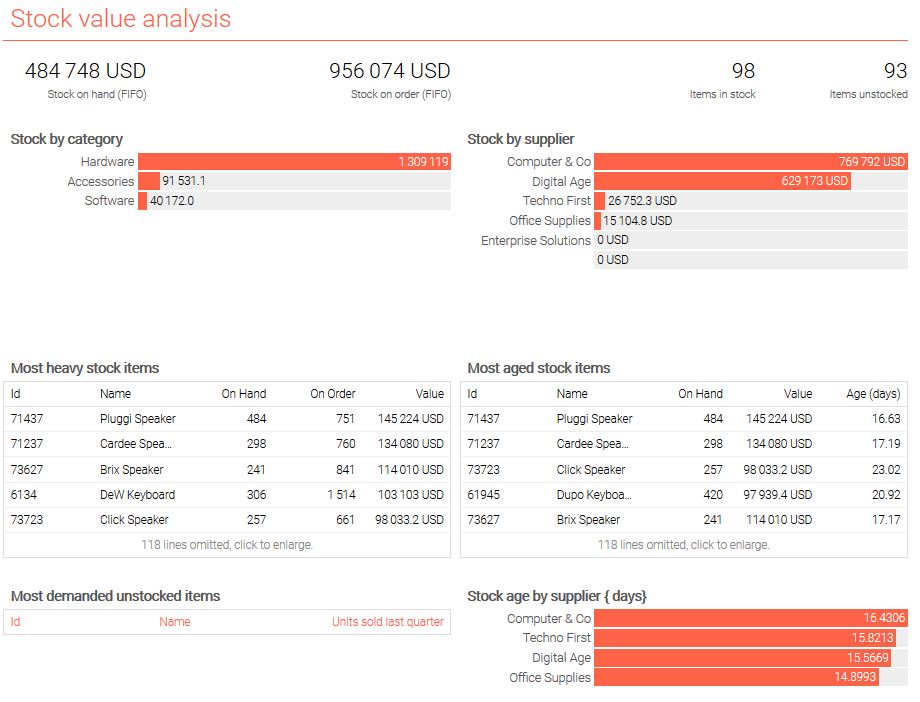Basic stock analysis
The script below illustrates how a stock analysis dashboard can be composed with Envision.
Check this script on the playground

/// Stock analysis - Lokad sample dataset 2017
read "/sample/Lokad_Items.tsv" as Items[id] with
"Id" as id : text
Name : text
Category : text
Supplier : text
StockOnHand : number
StockOnOrder : number
read "/sample/Lokad_Orders.tsv.gz" as Orders expect [id, date] with
"Id" as id : text
"Date" as date : date
Quantity : number
NetAmount : number
Currency : text
read "/sample/Lokad_PurchaseOrders.tsv" as PO expect [id, date] with
"Id" as id : text
"Date" as date : date
Quantity : number
NetAmount : number
Currency : text
show label "Stock value analysis" a1f1 { tileColor: tomato }
oend = max(Orders.date)
// Default currency, and currency conversions
currency = mode(Orders.Currency) when (date >= oend - 365)
Orders.NetAmount = forex(Orders.NetAmount, Orders.Currency, currency, Orders.date)
PO.NetAmount = forex(PO.NetAmount, PO.Currency, currency, PO.date)
// FIFO inventory valuation
PO.Fifo = fifo(Items.StockOnHand + Items.StockOnOrder, PO.date, PO.Quantity)
Items.Fifo = sum(PO.Fifo * PO.NetAmount / PO.Quantity)
PO.Fifo2 = fifo(Items.StockOnOrder, PO.date, PO.Quantity)
Items.Fifo2 = sum(PO.Fifo2 * PO.NetAmount / PO.Quantity)
// FIFO inventory age
StockAge = sum(PO.Fifo * (oend - PO.date)) /. sum(PO.Fifo)
// Top row of KPIs
show scalar "Stock on hand (FIFO)" a2 with sum(Items.Fifo - Items.Fifo2) { unit: #(currency) }
show scalar "Stock on order (FIFO)" c2 with sum(Items.Fifo2) { unit: #(currency) }
show scalar "Items in stock" e2 with count(Items.StockOnHand + Items.StockOnOrder > 0)
where date > oend - 31
where sum(Orders.Quantity) by id > 0
show scalar "Items unstocked" f2 with count(Items.*)
// Stock by category and supplier
show barchart "Stock by category" a3c5 { tileColor: tomato } with
sum(Items.Fifo)
group by Items.Category
order by sum(Items.Fifo) desc
{ unit: #(currency) }
show barchart "Stock by supplier" d3f5 { tileColor: tomato } with
sum(Items.Fifo)
group by Items.Supplier
order by sum(Items.Fifo) desc
// Most heavy stocked items, most aged stock items
show table "Most heavy stock items" a6c8 with
id
Items.Name
Items.StockOnHand as "On Hand"
Items.StockOnOrder as "On Order"
Items.Fifo as "Value" { unit: #(currency) }
order by Items.Fifo desc
show table "Most aged stock items" d6f8 with
id
Items.Name
Items.StockOnHand as "On Hand"
Items.Fifo as "Value" { unit: #(currency) }
StockAge as "Age (days)"
order by Items.Fifo * StockAge desc // mixing age and value on purpose
// Most pressured stock items
Items.D = sum(Orders.Quantity) where date >= oend - 13 * 7
where Items.StockOnHand + Items.StockOnOrder <= 0 and Items.D > 0
show table "Most demanded unstocked items" a9c11 { tileColor: tomato } with
id
Items.Name
Items.D as "Units sold last quarter"
order by Items.D desc
Items.V = sum(Orders.NetAmount) where date >= oend - 13 * 7
where sum(Items.V) by Items.Supplier > 0
show barchart "Stock age by supplier { days}" d9f11 { tileColor: tomato } with
sum(Items.V * StockAge) / max(1, sum(Items.V))
group by Items.Supplier
order by sum(Items.V * StockAge) / max(1, sum(Items.V)) desc